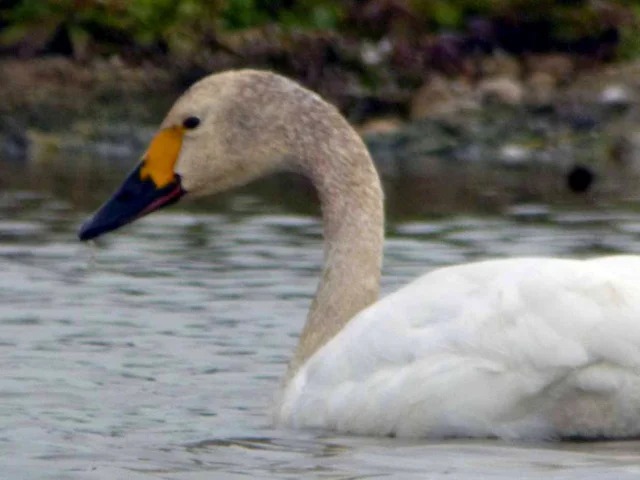Earliest swan means cold weather?
8888beff-29aa-4483-9bb7-f305b84636a1

The first Bewick’s Swan of the autumn arrived at Slimbridge WWT, Gloucestershire, this week – the earliest for over 50 years – adding to speculation that we are in for a bitter winter.
Wildfowl and Wetland Trust (WWT) studies have shown that the weather is a major influence on Bewick’s Swan movements from from Russia, with the wind direction being a particularly crucial factor. Unusually cold weather is currently sweeping parts of western Russia and Eastern Europe, with temperatures between 5-10° C below average.
The low temperatures, snowfall and north easterly winds have encouraged Bewick’s Swans to press on with their westwards migration through Europe. They are also currently gathering in The Netherlands, where there are 45 on Lake Gooimeer and 80 on Lake Lauwersmeer.
El Niño is underway in the tropical Pacific, prompting speculation that Europe is in for a long, cold winter. The early migration of Bewick’s Swans reflects that winter certainly has kicked off earlier than usual in many countries.
WWT’s Julia Newth said: “Apparently there’s a Russian saying [which goes]: 'the swan brings snow on its bill', because they tend to move just ahead of the cold weather. Of course, we can’t infer much from the arrival of a single swan but it’s certainly exciting this bird has arrived so early.
“It’s only a year old and, because it’s made it all the way here on its own, we assume that it must have come to Slimbridge last year as a cygnet with its parents. We record all the Bewick’s Swans that come to Slimbridge each winter by their unique bill pattern as part of our study, and give them a name. This one needed a name, so we’ve called him Record Breaker.”
The WWT started studying Bewick’s Swans at Slimbridge in 1963 and it is now one of the longest running studies on a single species. It was started by founder Sir Peter Scott, and each individual swan is recorded by the unique pattern of black and yellow on its beak.
The previous record for the earliest Bewick’s Swans to arrive at Slimbridge had been held by a pair named Tomato and Ketchup since 12 October 1980.
The public can see the Bewick’s Swans at Slimbridge, where they are fed daily from 1 November to the end of February. They can also be seen via the webcam www.wwt.org.uk/wetland-centres/slimbridge/experience/webcam/. For more on swans visit www.wwt.org.uk/swans.
Wildfowl and Wetland Trust (WWT) studies have shown that the weather is a major influence on Bewick’s Swan movements from from Russia, with the wind direction being a particularly crucial factor. Unusually cold weather is currently sweeping parts of western Russia and Eastern Europe, with temperatures between 5-10° C below average.
The low temperatures, snowfall and north easterly winds have encouraged Bewick’s Swans to press on with their westwards migration through Europe. They are also currently gathering in The Netherlands, where there are 45 on Lake Gooimeer and 80 on Lake Lauwersmeer.
El Niño is underway in the tropical Pacific, prompting speculation that Europe is in for a long, cold winter. The early migration of Bewick’s Swans reflects that winter certainly has kicked off earlier than usual in many countries.
WWT’s Julia Newth said: “Apparently there’s a Russian saying [which goes]: 'the swan brings snow on its bill', because they tend to move just ahead of the cold weather. Of course, we can’t infer much from the arrival of a single swan but it’s certainly exciting this bird has arrived so early.
“It’s only a year old and, because it’s made it all the way here on its own, we assume that it must have come to Slimbridge last year as a cygnet with its parents. We record all the Bewick’s Swans that come to Slimbridge each winter by their unique bill pattern as part of our study, and give them a name. This one needed a name, so we’ve called him Record Breaker.”
The WWT started studying Bewick’s Swans at Slimbridge in 1963 and it is now one of the longest running studies on a single species. It was started by founder Sir Peter Scott, and each individual swan is recorded by the unique pattern of black and yellow on its beak.
The previous record for the earliest Bewick’s Swans to arrive at Slimbridge had been held by a pair named Tomato and Ketchup since 12 October 1980.
The public can see the Bewick’s Swans at Slimbridge, where they are fed daily from 1 November to the end of February. They can also be seen via the webcam www.wwt.org.uk/wetland-centres/slimbridge/experience/webcam/. For more on swans visit www.wwt.org.uk/swans.

